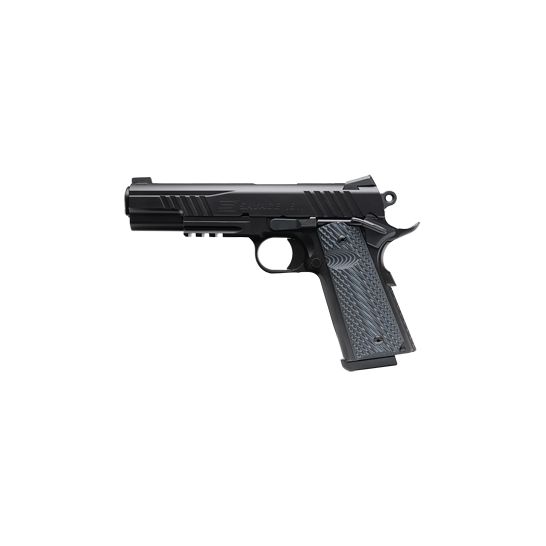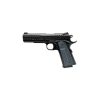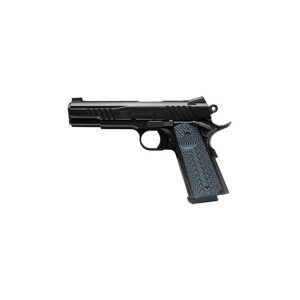Savage 9mm 1911 Pistol, 5" Barrel, Night Sights, Silver – 67211 For Sale
$1,243.99
The Savage 9mm 1911 Pistol combines classic design with modern innovation, honoring over a century of handgun evolution rooted in John Moses Browning’s legendary single-action semi-automatic. Constructed from robust stainless steel, this pistol showcases advanced features such as a dual recoil spring and precision-machined sear and disconnector for enhanced reliability and performance. Its design pays homage to the original that surpassed the Savage Model 1907 to become the US Military’s M1911, while its practical engineering supports rigorous use. The pistol’s striking silver finish and night sights enhance its appeal, making it a top choice for collectors and serious shooters alike.
How much is a new Savage 1911?
As of the latest available data, the Savage 1911 is priced at approximately $1,350, though prices can vary depending on the retailer and any additions or modifications. It’s a good idea to check with local gun shops or online retailers for the most current pricing and availability.
Is a 1911 better than a Glock?
The question of whether a 1911 is better than a Glock depends on a variety of factors, including personal preference, intended use, and specific requirements. Here are some points to consider:
1. **Design and History**:
– **1911**: A classic design with over a century of history, known for its single-action trigger, metal construction, and traditional feel. It’s renowned for its accuracy and ergonomics.
– **Glock**: A more modern design, known for its polymer frame, simplicity, and reliability. It’s often praised for its ease of use and high capacity.
2. **Trigger**:
– **1911**: Offers a crisp, light single-action trigger which many shooters appreciate for precision.
– **Glock**: Features a consistent trigger pull with its striker-fired design, which some shooters prefer for its simplicity and safety features.
3. **Capacity**:
– **1911**: Typically features a lower magazine capacity (often 7-8 rounds) given its single-stack magazine design.
– **Glock**: Generally offers higher capacity due to its double-stack magazine design, which can be beneficial for self-defense or duty use.
4. **Ergonomics and Grip**:
– **1911**: Known for its comfortable grip and customizable options, which can be ideal for shooters with specific ergonomic preferences.
– **Glock**: Has a reputation for a universal fit and modular backstraps to accommodate different hand sizes.
5. **Maintenance and Durability**:
– **1911**: Requires more maintenance due to its design and can be more susceptible to reliability issues if not well-maintained.
– **Glock**: Known for its ruggedness and low maintenance requirements, often considered highly reliable under adverse conditions.
6. **Price and Accessibility**:
– **1911**: Can vary widely in cost, especially for custom or high-end models.
– **Glock**: Generally more affordable and widely available, with a standardized design.
Ultimately, the choice between a 1911 and a Glock depends on what you prioritize in a firearm. Enthusiasts may prefer the 1911 for its historical significance and refined shooting experience, while professionals and some novices might favor a Glock for its practicality and reliability. Personal testing and handling are the best ways to determine which one suits your needs and preferences.
Why do 1911s jam so much?
The 1911 pistol, designed by John Browning, has a reputation for reliability, but there are several reasons why some 1911s might experience jamming issues:
1. **Tight Tolerances:** Some modern 1911s are manufactured with very tight tolerances to enhance accuracy, which can make them less forgiving and more prone to jamming if not properly maintained or broken in.
2. **Ammunition Sensitivity:** The 1911 was originally designed to fire .45 ACP ball ammunition. Using different types or qualities of ammo, such as hollow points or low-quality rounds, can sometimes lead to feeding and extraction issues.
3. **Magazine Issues:** The 1911’s functioning heavily relies on the magazine. Worn-out or low-quality magazines can cause feeding problems and contribute to jams.
4. **Improper Grip/Handling:** Limp-wristing, or not providing enough resistance when firing, can cause failures to eject or feed, particularly in recoil-operated pistols like the 1911.
5. **Lack of Maintenance:** Like any finely-tuned machine, a 1911 requires regular cleaning and lubrication. Dirt, debris, or insufficient lubrication can cause malfunctions.
6. **Aftermarket Modifications:** Many 1911 owners customize their guns. Poorly done modifications or incompatible parts can introduce various reliability issues.
7. **Recoil Spring Issues:** If the recoil spring is not matched well to the ammunition or becomes worn out, it can affect the slide cycle and lead to jams.
8. **Extractor Problems:** The 1911’s extractor is a critical component for reliable operation. If it is damaged, improperly tensioned, or dirty, it can cause extraction problems.
While the 1911 is a classic design, like any firearm, it requires proper maintenance and care to function reliably. Choosing a reputable manufacturer and keeping the gun well-maintained can mitigate many of these issues.
What is the best length for a 9mm 1911?
The best barrel length for a 9mm 1911 depends on your intended use and personal preferences. Common options include:
1. **Full-size (Government model)**: Typically has a 5-inch barrel. It’s ideal for target shooting and offers a longer sight radius, generally providing better accuracy. It can also handle recoil well.
2. **Commander**: Usually features a 4.25-inch barrel, making it a bit more compact while still maintaining good accuracy and handling. It strikes a balance between size and performance, often preferred for carry purposes.
3. **Officer**: Comes with a 3.5-inch or shorter barrel. This model is designed for concealed carry due to its smaller size but might offer less accuracy and increased perceived recoil.
Ultimately, the best length will depend on what you value most—accuracy, ease of carry, or concealability.
Be the first to review “Savage 9mm 1911 Pistol, 5" Barrel, Night Sights, Silver – 67211” Cancel reply
Related products
Savage 9mm 1911 Pistol
Savage 9mm 1911 Pistol, 5" Barrel, Night Sights, Black – 67204



Reviews
There are no reviews yet.